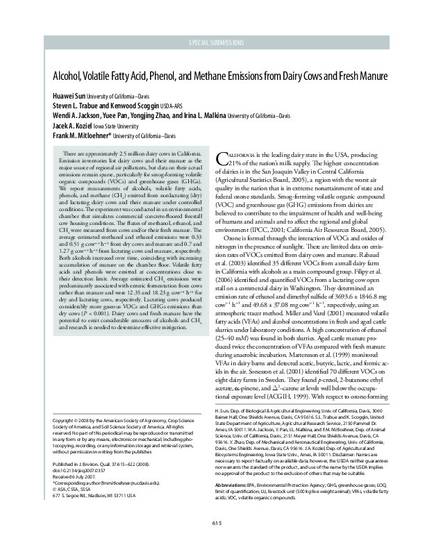
There are approximately 2.5 million dairy cows in California. Emission inventories list dairy cows and their manure as the major source of regional air pollutants, but data on their actual emissions remain sparse, particularly for smog-forming volatile organic compounds (VOCs) and greenhouse gases (GHGs). We report measurements of alcohols, volatile fatty acids, phenols, and methane (CH4) emitted from nonlactating (dry) and lactating dairy cows and their manure under controlled conditions. The experiment was conducted in an environmental chamber that simulates commercial concrete-floored freestall cow housing conditions. The fluxes of methanol, ethanol, and CH4 were measured from cows and/or their fresh manure. The average estimated methanol and ethanol emissions were 0.33 and 0.51 g cow−1 h−1 from dry cows and manure and 0.7 and 1.27 g cow−1 h−1 from lactating cows and manure, respectively. Both alcohols increased over time, coinciding with increasing accumulation of manure on the chamber floor. Volatile fatty acids and phenols were emitted at concentrations close to their detection limit. Average estimated CH4emissions were predominantly associated with enteric fermentation from cows rather than manure and were 12.35 and 18.23 g cow−1 h−1 for dry and lactating cows, respectively. Lactating cows produced considerably more gaseous VOCs and GHGs emissions than dry cows (P < 0.001). Dairy cows and fresh manure have the potential to emit considerable amounts of alcohols and CH4 and research is needed to determine effective mitigation.
Available at: http://works.bepress.com/jacek_koziel/8/

This article is from Journal of Environmental Quality 37, no. 2 (2008): 615–622, doi: 10.2134/jeq2007.0357.